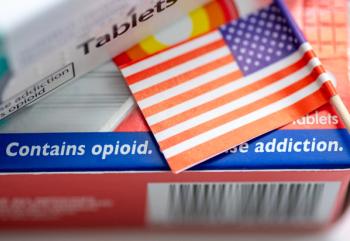
- Drug Topics August 2022
- Volume 166
- Issue 8
Pharmacists Fight to Take on Opioid Use Disorder
Buprenorphine can only be prescribed by pharmacists with waivers, limiting access to this necessary treatment for communities.
Opioid use disorder (OUD) and overdose deaths are an epidemic. During the COVID-19 pandemic, opioid overdose deaths in the United States soared by 45%—up to 107,622 drug overdose deaths in 2021, according to the CDC.1 Despite these high numbers, when individuals with OUD or their caregivers ask their pharmacist for help, the answer all too often is “I can’t.”
“The barriers to patient access to medication for opioid use disorder [MOUD] are decades old, entrenched in our clinics, our regulations, and our attitudes that stigmatize OUD and [individuals] who have OUD,” said Anna Legreid Dopp, PharmD, CPHQ, senior director of clinical guidelines and quality improvement at American Society of Health-System Pharmacists in Washington, DC. “But the evidence is there that MOUD reduces mortality and facilitates recovery, and we are seeing change.”
There are decades of data supporting the effectiveness of naltrexone, buprenorphine, and methadone to treat OUD, and nearly as many decades of legal and regulatory restrictions on their use. Naloxone—used to reverse acute opioid overdose— is the 1 clear success in the continuing battle against opioid fatalities, said Anne Burns, RPh, vice president of professional affairs for the Ameri- can Pharmacists Association in Washington, DC. Although naloxone saves lives, it does not treat OUD.
Naltrexone, a complete opioid blocker, is most commonly formulated as an injectable and is seldom used for MOUD due to inconvenience of routine injections and unwelcome adverse effects, including headache, fatigue, joint and muscle pain, loss of appetite, and vomiting. Methadone is a complete opioid agonist dispensed in pharmacies for analgesia but can be used for MOUD only in federally approved opioid treatment programs.
Buprenorphine, a partial opioid blocker, is also dispensed for analgesia. As a schedule III narcotic, it can be prescribed and titrated by pharmacists if the state practice act allows. However, prescribing or titrating the same buprenorphine for MOUD is restricted to clinicians who hold a waiver under the Drug Addiction Treatment Act of 2000 (DATA 2000).
These waivers, sometimes called X waivers, were originally restricted to physicians meeting specific training requirements. Subsequent legislation extended waivers to physician assistants and nurse practitioners—but not to pharmacists.
“Regulations that would allow for patients to receive the appropriate level of care where and when they need it, so [patients] could potentially receive methadone and buprenorphine in community pharmacies— and having pharmacists be able to prescribe or order these medications where it is part of their scope of practice— could go a long way to expanding access,” said Bethany DiPaula, PharmD, BCPP, FASHP, who is part of a primary care practice focused on substance use disorders in Baltimore, Maryland. She is also a professor and the director of the PGY2 Psychiatric Pharmacy Residency Program at the University of Maryland School of Pharmacy.
“I can enter buprenorphine prescriptions in our electronic order entry system, but they are actually prescribed by a practice physician, not by me,” she said. “That’s an extra step, an additional barrier, to providing treatment that works. Internationally, pharmacists provide MOUD in the community pharmacy setting, and there have been studies about expanding MOUD in community pharmacies in this country. DATA 2000 is the big hang-up.”
However, that could change. A coalition of pharmacy, medical, and other groups have been pushing both to expand DATA 2000 waivers to pharmacists and eliminate waiver requirements altogether. In June, the United States House of Representatives passed HR 7666, the Restoring Hope for Mental Health and Well-Being Act of 2022. The bill would eliminate the need for pharmacists and other clinicians to obtain a DATA 2000 waiver to administer MOUD but would continue current training requirements.
“Patients in need must have access, but this well-established solution is hindered by unnecessary and unproven bureaucratic processes,” said Timothy D. Fensky, RPh, DPh, president of the National Association of Boards of Pharmacy in 2021 in Suffolk County, Massachusetts. “Pharmacists are well positioned to help eliminate barriers and allow more patients with OUD to access the treatment they need.”
Facing the Stigma
Only approximately 20% of individuals who could benefit from MOUD actually get it, Burns noted. Stigma in the community, from law enforcement, government, and the health care industry, gets in the way.
“There are pharmacists who feel that if they dispense buprenorphine, [they are] trading one addiction for another,” Burns said. “Some addiction specialists say it is being diverted onto the street, which is probably a good thing. If someone uses buprenorphine vs heroin or fentanyl, it is very unlikely they are going to overdose. MOUD requires a different mindset.”
Of this mindset, some in law enforcement are taking note. “The chief barriers to expanding MOUD access...are often based on misguided stereotypes and stigmas about the treatment and diversion concerns,” wrote Assistant United States Attorneys David Sinkman, of the Eastern District of Louisiana, and Gregory Dorchak, of the District of Massachusetts in the Department of Justice Journal of Federal Law and Practice in 2020.3 “Equating the prescription use of MOUD with addiction overlooks the fact that most chronic diseases require long-term use of medication. [Although] those with high blood pressure are dependent on their β-blocker medication, they are not addicted. The same holds true for MOUD.”
Buprenorphine has low potential for abuse because it blocks opioid euphoria and other positive reinforcement. Its appeal on the street is that it also blocks opioid craving. “I’ve had new patients who can tell me what dose of buprenorphine they need because they’ve been using it on the street to treat themselves,” DiPaula said. “There is good data showing that a subset of diversion is associated with self-medication.”
But unfortunately, pharmacists are no less likely to stigmatize OUD than other providers. “The long-term data show medication helps prevent relapses and helps [individuals] to be opioid-free, productive members of their community,” said Grace Allen, RPh, chief operating officer of Pursue-Care, a telehealth startup specializing in mental health and substance use disorder treatment in Huntington, West Virginia. “It’s like the difficulties getting oral contraceptives when they first came out. The stigma and judgement that any woman trying to get that prescription filled at the pharmacy [faced] was almost overwhelming. It’s the same kind of situation for patients [with substance use disorder] trying to get their medications.”
Regulation and Reimbursement
It’s not just individual pharmacists prejudging patients, Allen noted that some pharmacy chains discourage out- lets from accepting patients who need MOUD or from filling MOUD prescriptions. “Wholesalers have certain controlled substance dispensing patterns they expect to see, and chains don’t want to lose their ability to purchase,” she said. “It’s terrifying to think you could be cut off from ordering medications because you don’t fit an algorithm that doesn’t take substance use disorder medications into account.”
In turn, wholesalers are trying to avoid attention from the Drug Enforcement Administration (DEA), which has cracked down on opioid sales in recent years. It is unclear how the DEA views MOUD dispensing. The agency touted steps taken to expand access to MOUD in a March 2022 press release, a list that includes “engaging in regular outreach with pharmacists and practitioners to express support for the use of medication-assisted treatment for those suffering from substance use disorder.”
But what that outreach has accomplished is unclear. “DEA is hearing from a lot of advocacy groups, including ASHP,” Dopp said. “There is positive momentum with other stakeholder groups to try to educate and advocate within the DEA to create change.” Ongoing discussions with the agency have brought no discernable changes in policy or enforcement, she added.
“It’s a tangled web of barriers for pharmacists who want to take care of patients,” said Hannah Fish, PharmD, CPHQ, director of strategic initiatives for the National Community Pharmacists Association in East Greenwich, Rhode Island. “All these regulations effectively limit access to care rather expanding access.”
On top of navigating these barriers, MOUD can also be a financial strain, as it is a time-intensive, high-touch practice. Few payers adequately reimburse pharmacists for the time involved. “[When] treating [patients with] substance use disorder, you have to think back on why you got into pharmacy,” Allen said. “When you see in real life how these people have turned their lives around with good care and the right medication at a pharmacy that doesn’t give them a hard time about filling their prescriptions, it reminds you why you got into this practice in the first place.”
References
- Atkins J, Dopp AL, Temaner EB. Combatting the stigma of addiction—the need for a comprehensive health system approach. NAM Perspect. 2020;2020:10:31478/202011d. doi:10.31478/202011d
- Sinkman DH, Dorchak G. Using the Americans With Disabilities Act to reduce overdose deaths. Dep Justice J Fed Law Pract. 2022;70(1):113-127.
- Ending the stigma of addiction. Shatterproof. Accessed July 13, 2022.
https://www.shatterproof.org/our-work/ending-addiction-stigma - Report of the ASHP Opioid Task Force. Am J Health Syst Pharm. 2020;77(14):1158-1165. doi:10.1093/ajhp/zxaa117
- Opioid use disorders. College of Psychiatric and Neurologic Pharmacists. Accessed July 13, 2022.
https://cpnp.org/ed/oud - Learning tools. ONE (Opioid and Naloxone Education). Accessed July 13, 2022.
https://one-program.org/pharmacists/ - Action collaborative on countering the U.S. opioid epidemic. National Academy of Medicine. Accessed July 13, 2022.
https://nam.edu/programs/action-collaborative-on-countering-the-u-s-opioid-epidemic/ - Training and webinars. American Pharmacists Association. Accessed July 13, 2022.
https://pharmacist.com/Practice/ Patient-Care-Services/Opioid-Use-Misuse/Opioid-Training-and-Webinars
Articles in this issue
over 3 years ago
Managing ADHD in Children and Adultsover 3 years ago
At a Glance: Interim COVID-19 Immunization Scheduleover 3 years ago
Vivjoa Approved for Recurrent Vulvovaginal Candidiasisover 3 years ago
What's Coming in the 2022-2023 Flu Seasonover 3 years ago
Pendulum Ping Pongover 3 years ago
Become the Pharmacy of the Future With Technology SolutionsNewsletter
Pharmacy practice is always changing. Stay ahead of the curve with the Drug Topics newsletter and get the latest drug information, industry trends, and patient care tips.















































































































